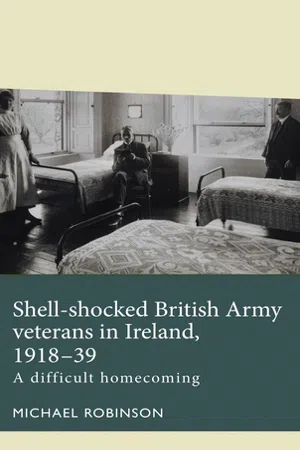![]()
1
‘A definitive neurasthenic temperament’? The Irish Tommy and veteran
Introduction
There was negligible medical provision for mental and nervous casualties before the First World War. The 955-bed Royal Victoria Military Hospital at Netley provided just 125 beds for such cases within its ‘D Block.’ The Lunacy Act of 1890 enabled discharge from the army, certification and a transferral to an asylum.1 During the Second Anglo-Boer War, 1899–1902, severely mentally ill troops in both South Ireland and Ulster were discharged from the army and admitted into their local district asylum. Irish servicemen subsequently shared the ignominy and stigma associated with pauper lunacy.2 The First World War would dramatically change the treatment of war-induced psychoneuroses. The War Office's official medical history of the conflict went so far as to write that shell-shock ‘raised the psychoneuroses to the dignity of a new war disease before which doctors seemed well-nigh helpless.’3
An investigation of mentally disabled Great War veterans will begin where the majority of such illnesses manifested: the Western Front. Two-thirds of Irish battalions spent the entire duration of the war in this theatre which was responsible for almost 31,000 war-dead from Irish Regiments equating to 82 percent of fatalities.4 The British military and medical authorities paid little heed to forewarnings that modern industrial warfare would contribute to a higher number of mental and nervous casualties. Mental and nervous casualties were treated on an ad-hoc basis during the early stages of the First World War. Casualties were cared for wherever they could be placed including military hospitals and wards in general hospitals.5 A basic network of treatment facilities was established for psychoneurotic casualties by 1915. This infrastructure included a treatment facility set up at the No. 26 General Hospital near Etaples with ‘insane’ cases segregated and housed in a small hut. Additional ‘mental blocks’ were placed at other base hospitals throughout the war.6 In 1916, coinciding with the Somme Campaign where the British Army haemorrhaged manpower, an attempt to combat losses was made with the British Army introducing the concept of ‘forward psychiatry.’ This intervention established specialised treatment centres behind trench front lines. These units worked towards the ‘PIE’ system which focused on three core objectives: Proximity of treatment to the area of service; Immediacy of response to symptoms; Expectation of recovery. The most chronic and acute cases were referred to the United Kingdom for further treatment. The Royal Victoria Hospital in Netley, the No. 4 London General Hospital in Britain and the King George V Hospital in Dublin would often act as clearing stations in the UK. Following an initial assessment, servicemen were transferred to suitable hospitals for further treatment including, for example, the Red Cross Military Hospital in Maghull or the National Hospital for Paralysed and Epileptic, Queen Square, London.7 Psychoneurotic men were also sent to newly established War Hospitals established on district asylum grounds. Approximately 4,470 asylum beds were available for the treatment of servicemen's mental and nervous injuries.8 This number included a thirty-two-bed segregated Richmond War Hospital adjunct to the Richmond District Lunatic Asylum and the Belfast War Hospital which displaced the entire population and grounds of the Belfast District Lunatic Asylum.
Varying responses to shell-shock were apparent across these medical and military establishments as practitioners sought to balance caregiving without depleting manpower. Each medical centre's treatment philosophy largely echoed the professional backgrounds of its senior medical staff, although it was not uncommon for different medical judgements and approaches to be evident within the same institution. Some military and medical officials favoured a somatic explanation, believing shell-shock to be the result of physical shock or concussion. Failing these causative agents, a more disciplinary approach emphasising faulty hereditary explanations or moral degeneracy were to blame. This method was arguably most infamously personified by Dr L. R. Yealland's treatment of shell-shocked soldiers via faradism or electrical shock therapy. There was also a continuation of the long-established Weir–Mitchell treatment for neurasthenia which administered bromide medication, a milk diet, rest, recuperation, massage and drugs to assist in a soldier's recuperation. By contrast, psychotherapeutic treatment encouraged patients to adjust their thought processes when suffering from ailments such as anxiety and depression, rationalising negative thoughts and increasing the regularity and magnitude of positive ones.9 R. G. Rows preferred this ethos of abreaction for staff at Red Cross Military Hospital in Maghull, Liverpool, as did W. H. R. Rivers at his comparative hospital reserved for the officer class at Craiglockhart War Hospital in Edinburgh.10 Edgar Jones assesses that the core change in ethos at Maghull was to reconvene diagnoses such as hysteria and neurasthenia not as ‘functional nervous’ disorders but as variants of ‘psychoneurosis.’ While some practitioners emphasised the pathological change in the nervous system of a soldier-patient, medical staff associated with Maghull disputed this claim underlining a mental or psychological reason. At its most basic level, these practitioners emphasised nurture over nature in explaining combat neurosis.11 With this outlook and associated treatment, Leese argues that these hospitals were ‘the most humane of the British centres’ for neurasthenic servicemen.12 The division between organic and psychological causation amongst the medical network was not total. Instead, individual facilities and staff often centred an emphasis on either outlook.13 Thomas Webb writes that these differing treatment philosophies constituted a ‘desperate and disparate set of responses to the problems posed by the reality of the shell-shock epidemic.’14
Irishmen experienced psychoneurotic afflictions alongside their British-born comrades during this evolution from a patchwork of military medical facilit...
